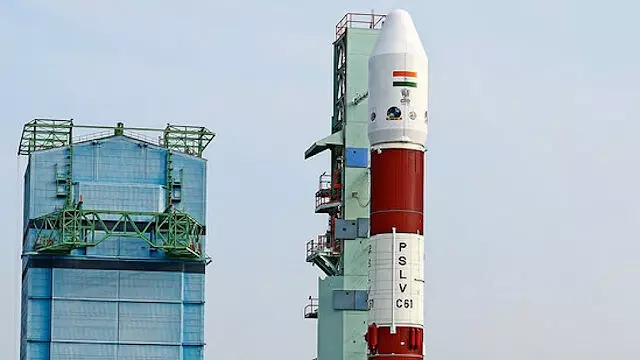ISRO’s 101st Mission Fails: A Setback in India’s Space Ambitions

India's ambitious space program faced a rare setback with the failure of ISRO’s 101st mission, a crucial Earth observation satellite launch that aimed to enhance the country’s surveillance and land mapping capabilities. The anomaly, detected in the third stage of the Polar Satellite Launch Vehicle (PSLV-C61), led to the unsuccessful deployment of the EOS-09 satellite, raising concerns about the reliability of one of ISRO’s most dependable launch vehicles. While the Indian space agency has a long history of overcoming failures and refining its technology, this latest setback puts ISRO in a challenging position, both in terms of future launches and its standing in global space efforts.
The PSLV, often referred to as ISRO’s workhorse, has been responsible for launching multiple successful missions, including interplanetary probes and commercial satellite payloads for international clients. However, the third-stage anomaly during this launch exposed vulnerabilities in India’s space infrastructure at a time when precision in satellite deployment is critical for national security, environmental monitoring, and disaster management.
The EOS-09 satellite was designed to provide high-resolution imaging using synthetic aperture radar, a technology capable of capturing detailed data irrespective of weather conditions or time of day. Its intended role in border surveillance and mapping sensitive terrain underscores its significance, making this failure more than just a technical setback—it has strategic implications for India's defense and remote sensing capabilities.
Technical failures in rocket launches are not uncommon, even among spacefaring giants such as NASA, Roscosmos, and CNSA. ISRO itself has encountered mission failures in the past, most notably during the Chandrayaan-2 lunar landing attempt. However, what makes this instance particularly concerning is its occurrence in the third stage of the launch, a phase where the satellite should have been positioned correctly for orbital insertion. Early assessments suggest that either a propulsion defect, irregular propellant flow, or a mechanical malfunction could have contributed to the failure. A detailed inquiry, led by ISRO’s Failure Analysis Committee, will examine telemetry data, structural integrity, and engine performance to pinpoint the exact cause.
India’s rapid advancements in space technology have placed ISRO in a highly competitive global position. The agency is no longer merely a reliable commercial satellite launcher; it has become a strong contender in deep-space missions, interplanetary exploration, and human spaceflight. The setback from PSLV-C61 raises questions about whether ISRO needs to rethink aspects of its mission design or conduct more rigorous ground testing. Comparisons with past failures show that ISRO has historically been swift in diagnosing problems and implementing corrective measures, often turning setbacks into stepping stones for future success. The quick recovery from previous launch failures suggests that ISRO will likely enhance third-stage ignition testing protocols and propulsion system evaluations before its next major launch.
The failure also comes at a time when India is working to establish a broader international presence in space collaboration. The Indian National Space Promotion and Authorization Center (IN-SPACe) has been fostering private-sector partnerships, aiming to make India a hub for satellite manufacturing and commercial launches. With more nations recognizing India’s expertise, setbacks like this can have implications beyond ISRO, affecting India’s ability to secure contracts for launching foreign satellites. Despite this failure, ISRO’s reputation remains largely intact, as its track record of innovation and reliability outweighs occasional missteps.
From a strategic standpoint, the failure of EOS-09 could impact India’s ability to expand its space-based surveillance network. As regional security threats evolve, the demand for high-resolution Earth observation has never been greater. With China rapidly advancing its own satellite capabilities, particularly in intelligence gathering and military reconnaissance, India cannot afford prolonged gaps in its surveillance infrastructure. This setback will likely prompt ISRO to accelerate its upcoming launches to ensure continuity in satellite-based defense applications.
Moreover, India’s domestic expectations for space missions have significantly evolved. No longer seen merely as scientific endeavors, ISRO’s launches carry political and economic weight. Government investment in space technology has increased, and failures—no matter how rare—invite scrutiny from policymakers and the general public. The EOS-09 mission failure could serve as an inflection point, prompting reassessments of long-term space strategies, funding allocations, and collaboration frameworks with international agencies.
ISRO’s response to this setback will determine whether India can maintain its upward trajectory in space exploration. The agency has announced that four more PSLV launches are scheduled for 2025, signaling confidence in its ability to move past this failure. Historically, failures have driven ISRO to innovate and improve its systems rather than retreat. If that pattern holds true, the lessons learned from the third-stage anomaly will result in technical refinements, enhanced risk assessments, and more stringent pre-flight evaluations.
In a broader sense, India’s space ambitions remain unshaken. The upcoming Gaganyaan human spaceflight mission, advancements in deep-space exploration, and inter-agency collaborations with NASA and ESA reinforce India’s position as an emerging space power. While the 101st mission’s failure is undeniably disappointing, the resilience of ISRO and its ability to recover will ultimately define its success. The true test lies not in avoiding failures but in how quickly and effectively lessons are learned and applied to future missions.
